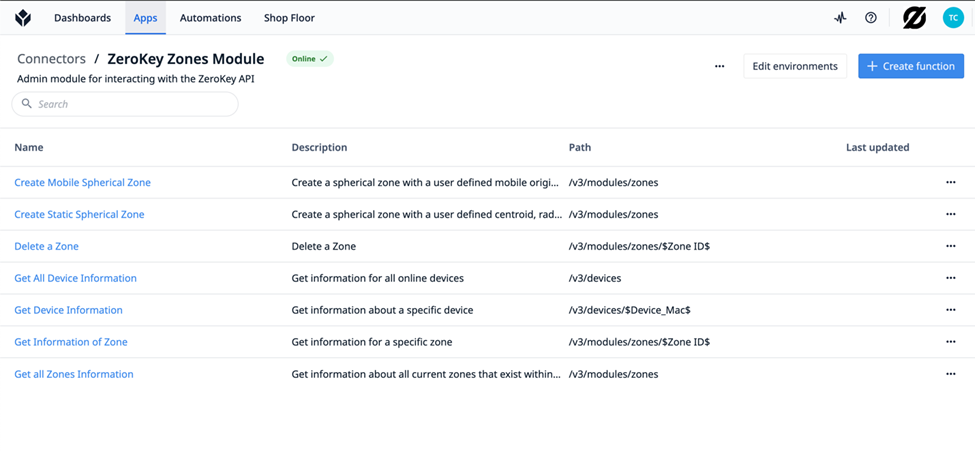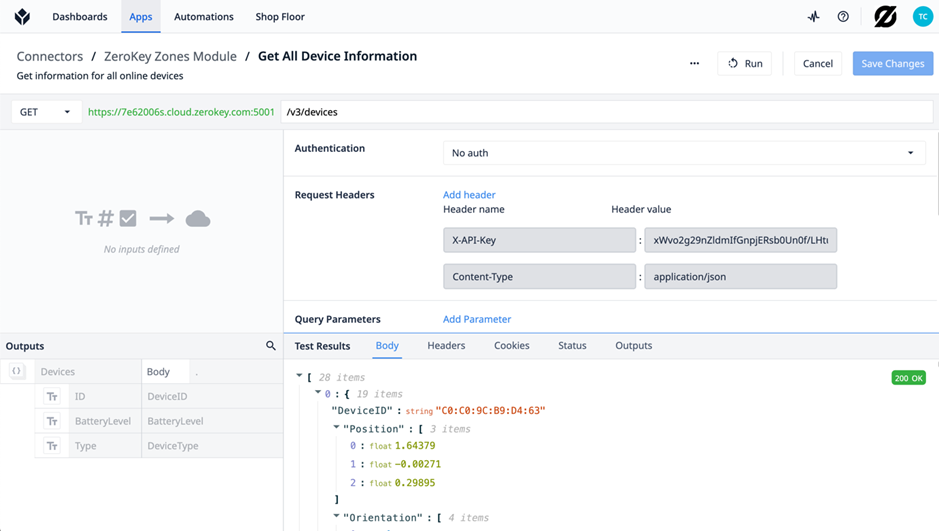Connecting the ZeroKey Zones API to Tulip Connectors
Integrate administrative capabilities, such as creating or deleting zones, into the Tulip Frontline Operations Platform using Tulip Connectors. The ZeroKey Zones Module Connector Suite offers prebuilt functionality for common features and is automatically installed when any ZeroKey Spatial MES Extension app template is added to your Tulip account. It can also be installed as a standalone package from the Tulip library.
This connector suite is intended to supplement the ZeroKey Custom Widgets by incorporating request-response access to common features of the ZeroKey API. For one way flow of real-time data into the Frontline Operations Platform such as using live position and zone events to trigger actions within an app, use the ZeroKey Custom Widgets to connect your app to your ZeroKey Event Hub.

Prerequisites
An existing Quantum RTLS 2.0 deployment with ZeroKey SIP 2.3.0 or higher.
To verify your SIP version in the dashboard, click the ZeroKey Logo in the top left corner.
Connection of your Edge Compute Device to a network with unrestricted internet access.
A professional or enterprise subscription to Tulip Interfaces.
Obtain your Edge Compute Device’s (ECD’s) Cloud URL
In the ZeroKey dashboard, navigate to the System tab and go to the Information menu. Here, you’ll see values in the ECD Edge URL, ECD Cloud URL, ECD Serial Number, and Hardware Identifier fields. For more information, read our help article Edge vs Cloud Connection to the ZeroKey ECD.

Connection to the ZeroKey API through Tulip Connectors requires the Cloud URL. The ECD must be connected to a network with unrestricted internet access to ensure the API is accessible through Tulip’s Cloud Connector Host.
Configure the Connector Environment Settings
Begin by copying the ECD Cloud URL into the Server Address field within the Environment Settings pane, matching the exact formatting shown in the image below. Be sure to remove the https:// before continuing.
Confirm TLS is toggled to Yes.
Select the Use custom port checkbox and enter 5001 as the chose port.

Add your Edge Compute Device’s (ECD’s) API Key
If you haven’t already generated an API Key, read our article Generating the API Key using Postman for information on how to obtain one. Once the API Key is generated, add it to the Header section within the Environment Settings pane as shown in the image below.
Ensure that you use the API Key and not a Bearer Token in this field.

Test the Connection using Get All Device Information Connector
Click on the Get All Device Information connector and click Run. Within the response body, you will see an array of objects corresponding to all the Mobile and Anchor devices connected to the system, as well as a status indicating that the request was successful. This confirms that your environment is configured successfully and ready to use.

Example 1
Creating a New Zone from within a Frontline Application
A trigger tied to a Tulip button press event is a simple and easy way to create zones from right within a Frontline Application. The ZeroKey Zones Module Connector Suite currently supports the creation of spherical zones, which can be either static or centered around a ZeroKey Mobile device so that the zone can move throughout the environment following the device it is associated with, such as a forklift, AGV or other mobile equipment.
The following example demonstrates a trigger that will run the connector function to create a static zone with values tied to other app variables.

Example 2
Loading All Zones and Devices to an App Table
An On step enter Trigger can be used to load all the active zones and devices from your Quantum RTLS 2.0 deployment to an object array local app variable. Once loaded, these values can easily be displayed and selected from interactive tables, making it simple and intuitive to build customized admin pages for spatial intelligence apps in Tulip such as in the template below.


